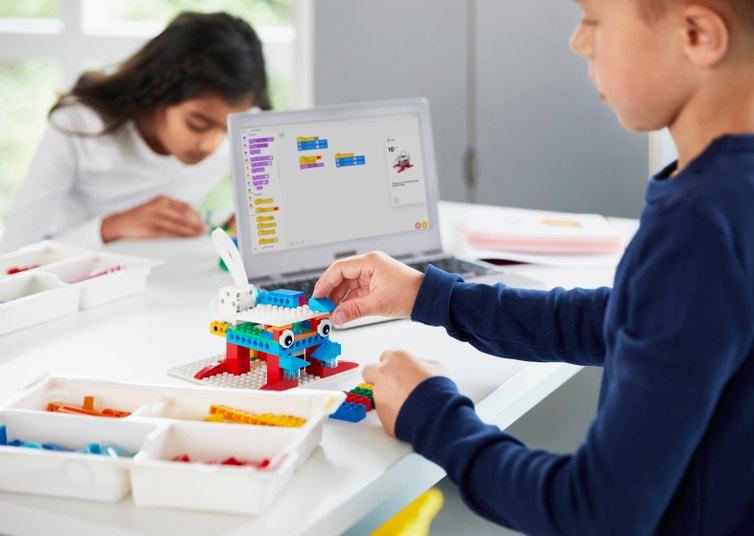Tapping the Potential of Learning Through Play in STEAM Programs
Encouraging purposeful play through tools such as LEGO Education to engage students and improve STEAM learning outcomes

We know children thrive through play, but did you know that learning through play is a powerful research-backed strategy to boost student engagement in the classroom?
“When students are playing, they’re unlocking their natural curiosity and finding their joy in learning,” said Dr. Jenny Nash, Head of Education Impact, US, for LEGO Education, during a recent virtual Tech & Learning roundtable discussion. “And when students learn in a purposeful, hands-on way it builds their confidence, and lessons can really become more motivating and meaningful. Purposeful play is rooted in pedagogical approaches, such as project-based learning, and it's really known to increase student learning outcomes."
During the event, experts shared evidence from both research and practice that demonstrate the connection between play and learning. Attendees heard about strategies and resources to incorporate purposeful play into their STEAM classrooms to help kids develop cognitive, emotional, physical, social, and creative skills, all using a research-based approach and real classroom examples.
The roundtable is available free on-demand here
Key Takeaways
Failing Forward. Learning through play allows students to try things and fail, and then learn from that, said Nash. “If we can have that meaningful failure, if we give students an opportunity to unlock their thinking and make their thinking visible and share what it looks like as they're creating and building, and we give them that chance to fail with it and learn from that – hey, it's not a failure, it's just an iteration of learning,” she said. “And now, they’re like, ‘I'm gonna be able to take some knowledge and change that, tweak it, and try something else out.’”
Obviously, hands-on tools such as LEGO Education building kits and solutions provide these opportunities. “LEGO has such a great low floor and high ceiling for learning,” said Susan McGrath, District Digital Learning Coach for Fayette County Public Schools in Kentucky. “It accommodates failure and creates some great productive struggle. I feel like I'm tricking them sometimes into learning.”
Future ready. Having such a familiar tool as LEGO available is especially helpful with younger students. “Being able to introduce LEGO tools into the classroom allowed my first-grade students to work and learn at their own pace, and be comfortable. For many of them, this was their first in-person experience in school,” said Joey Tanaka, EdTech and Robotics Specialist at Bertschi School in Seattle and a LEGO Education Master Educator. “Our job is to find the right learning level for each student.”
Tech & Learning Newsletter
Tools and ideas to transform education. Sign up below.
When introducing a tool such as a LEGO kit, to get a sense of it, Tanaka likes to first give it to someone who is competent and then a student who maybe has never worked with LEGO. “Recently, on the very first night I gave a kit to a student, I got this late-night email from her mother, and I was like, ‘Oh, great. Maybe I should have coached her more and provided more guidance.’ And the email said this: ‘We really didn't have time to help her, and so we just passed her the box.’ Then they heard this: ‘This is like the coolest thing I’ve ever seen!’”
Using playful and hands-on learning can sometimes engage students who might not otherwise participate, said McGrath. It also can open the door to other opportunities and types of learning.
“Research just continues to show that if we can embed the knowledge and skills, if we can embed that social-emotional learning through those types of experiences, at the end of the day, our students become confident and resilient learners,” said Nash. “They're going to be ready for whatever that future holds.”
Cross-curricular connections. A hands-on such as a robotics kit can be used to make connections across content areas. For example, Tanaka discussed how he watched as one student tried to create a faster car, and how adding elements to boost power, such as extra engines and wheels, didn’t really add to the speed. As the student worked, he started to explore other variables, including weight and air resistance, which opened the door to a physics lesson. “This is a perfect example of how our goal as teachers is really to have the kids puzzle things out on their own,” he said. “LEGO is really excellent for that, showing kids things that are really hard to show at times, like motion or speed. It was just a phenomenal moment as a teacher.”
McGrath is working with her district’s math and science specialists to bring in LEGO Education into more classrooms. “I actually was at one of our elementary schools, and they brought in their science class to the library for a STEM lesson. And we did a LEGO activity and the students loved it. And to hear them talk with the science teacher about concepts that she had already been teaching – I wish I had a picture of her face because she was kind of jaw-dropped as the students were mentioning things she had talked about, and they were actually seeing it in action in their build.”
Just do it. In regard to adopting STEAM learning through play, McGrath said to educators, “Don't be afraid. Jump in. Try just try.”
“Be flexible,” said Tanaka.
“You can do it,” said McGrath. “Just have faith.”
Ray Bendici is the Managing Editor of Tech & Learning and Tech & Learning University. He is an award-winning journalist/editor, with more than 20 years of experience, including a specific focus on education.
